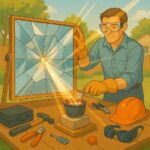Are you ready to embark on a fun and educational DIY project that brings physics to life? Building a balloon car is an exciting activity that not only sparks creativity but also helps you understand the concept of elastic energy. In this blog post, we’ll guide you through the process of creating your very own balloon-powered car, while exploring the science behind its motion.
What is Elastic Energy?
Before diving into the project, let’s take a moment to understand what elastic energy is. Elastic energy is the potential energy stored in elastic materials when they are stretched, compressed, or deformed in any way. This energy is released when the material returns to its original shape. In the context of a balloon car, elastic energy is stored in the balloon when it’s inflated and then released as the balloon deflates, propelling the car forward.
Materials Needed
Here’s a list of materials you’ll need to build your balloon car:
- Cardboard or plastic bottle: This will serve as the base of your car. A plastic bottle is ideal, but a piece of cardboard can work too.
- Straws: You’ll need two straws—one to create the axle for the wheels and another to serve as the balloon’s nozzle.
- Balsa wood or plastic sticks: These will be used to create the axles for the wheels.
- Small wheels: You can use toy car wheels or create your own using bottle caps or small pieces of cardboard.
- Glue or hot glue gun: To hold everything in place.
- Scissors: For cutting the straws, cardboard, and other materials.
- A balloon: The larger the balloon, the more elastic energy you’ll have.
- Tape: To secure the balloon in place.
- Markers or paint: To decorate your car.
- Ruler or straightedge: To draw straight lines.
- Optional: Decorations: You can add stickers, paint, or other embellishments to make your car unique.
Step-by-Step Instructions
Step 1: Design Your Car’s Base
Start by designing the base of your car. If you’re using a plastic bottle, cut off the top third to create a stable surface. If you’re using cardboard, cut out a rectangular shape that’s wide enough to accommodate your wheels.
Step 2: Create the Axle
Take one of the straws and cut it into two equal pieces. These will serve as the axle for your car’s wheels. If you’re using balsa wood or plastic sticks, you can skip this step.
Step 3: Attach the Wheels
Attach the wheels to the axle. If you’re using toy car wheels, simply insert the axle into the wheel’s hub. If you’re using bottle caps or cardboard, poke a small hole in the center and slide the axle through. Secure the wheels in place using glue.
Step 4: Assemble the Car’s Chassis
Take the base and attach the axle to it. Make sure the axle is centered and evenly spaced. If you’re using a straw, you can tape it in place. If you’re using balsa wood or plastic sticks, glue them to the base.
Step 5: Create the Balloon’s Nozzle
Take the second straw and cut it to the length of your balloon. This will act as the nozzle through which the air from the balloon will flow. Attach the nozzle to the base of the car, making sure it’s aligned with the axle.
Step 6: Secure the Balloon
Inflate the balloon slightly and attach it to the nozzle. Use tape to secure it in place. Make sure the balloon is tightly sealed so that no air escapes.
Step 7: Test Your Car
Find a smooth, flat surface and gently place your car on it. Squeeze the balloon to release the air through the nozzle. Watch as your car moves forward, powered by the elastic energy stored in the balloon!
The Science Behind It
Now that you’ve built your balloon car, let’s explore the science that makes it work.
Elastic Energy in Action
When you inflate the balloon, you’re stretching the rubber, which stores elastic potential energy. When you release the balloon, this energy is converted into kinetic energy as the air rushes out of the balloon, propelling the car forward.
Newton’s Third Law
Newton’s third law states that for every action, there is an equal and opposite reaction. In this case, the action is the air rushing out of the balloon, and the reaction is the car moving forward.
Friction and Motion
The movement of the car is also influenced by friction. The smoother the surface, the less friction there will be, allowing your car to travel farther. You can experiment with different surfaces to see how this affects your car’s performance.
Tips and Variations
Experiment with Different Balloons
Try using balloons of different sizes to see how they affect your car’s performance. A larger balloon will store more elastic energy, potentially making your car go faster or farther.
Modify the Nozzle
Adjust the length and width of the nozzle to see how it affects the airflow. A narrower nozzle will increase the speed of the air, while a wider nozzle will allow more air to flow at once.
Change the Wheels
Experiment with different types of wheels to see how they affect your car’s motion. Smaller wheels may allow your car to go faster, but they might also make it less stable.
Add a Steering Mechanism
If you’re feeling ambitious, you can add a steering mechanism to your car. This could be as simple as attaching a small lever to the front axle that you can use to steer the car.
Decorate Your Car
Let your creativity shine by decorating your car. Paint it, add stickers, or even attach small LED lights to make it stand out.
Conclusion
Building a balloon car is a fun and educational activity that allows you to explore the concept of elastic energy. By understanding how this energy is stored and released, you can create a car that moves purely on the power of air. Whether you’re a student looking for a science fair project or just someone who loves DIY experiments, this activity is sure to provide hours of entertainment and learning.
So, gather your materials, get creative, and watch as your balloon car comes to life!



